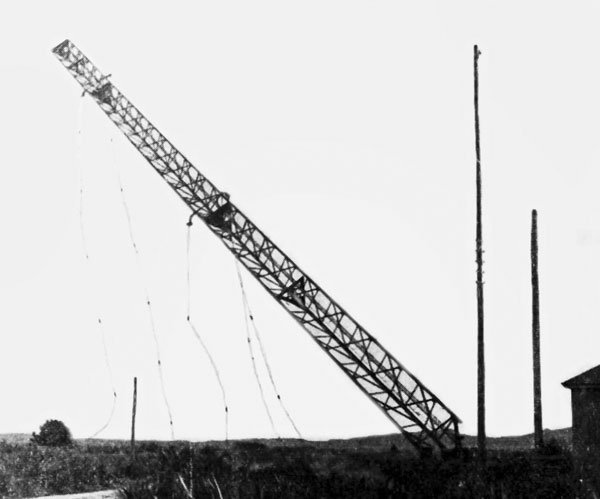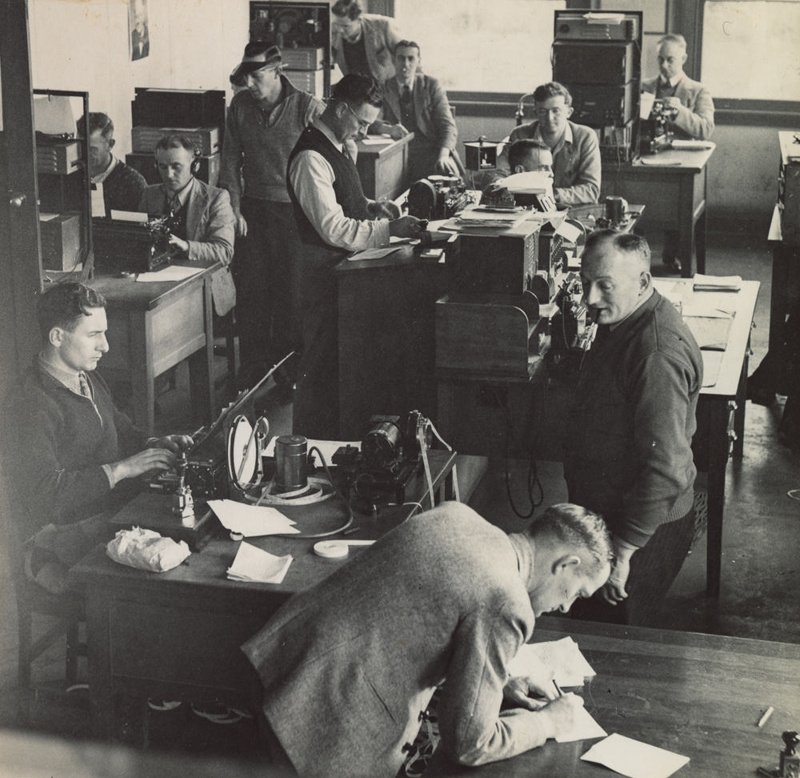Awarua Radio Station was a New Zealand Post & Telegraph Department communications station located on the Southland plains between Invercargill and Bluff. It opened for service on 18 December 1913 and closed on 30 August 1991.
At a wireless telegraphy conference held in Melbourne in December 1909, delegates met to discuss a scheme for connecting New Zealand, Australia, and the Pacific Islands by wireless. Following the conference, the New Zealand Government commissioned two high-power and several low-power wireless stations around the country.
The high-power stations were at Awarua, between Invercargill and Bluff, and at Awanui, just north of Kaitaia in Northland. The low-power stations were located in Auckland, Wellington, the Chatham Islands and aboard the Government steamship Tutanekai. Together these stations created a communications network around the country for both military and civilian use and were part of a wider network of British stations in Australia and Fiji.
Awarua wireless station
By 1911 the Government had provisionally selected the locations for its two high-power stations and had let contracts for the manufacture and installation of Telefunken wireless equipment to the Australasian Wireless Company (Limited).
Of the two main wireless telegraphy systems available – Marconi and Telefunken – the Government chose to install the German Telefunken system despite the political tensions of the day. Telefunken was selected for its lower installation and running costs. German engineers from Telefunken made the final selection of the 100-acre site on the Awarua Plains, where an absence of nearby hills gave the station a long range.
The design of the stations at Awarua and Awanui were based on the Telefunken Company’s experimental station at Nauen, near Berlin. The mast at Awarua was a triangular steel lattice structure 125 metres tall and 2.7 metres across each side. It supported an umbrella aerial with an output of 15kW. The base of the mast rested on an insulator made of glass discs interspersed by metal plates and was held in position by guy wires anchored in large concrete foundations.

"The glass insulators in position ready for the placing of the pivot and the lowering of the tower." E Chaplin Photo, Auckland Weekly News, 29 May 1913. Sir George Grey Special Collections, Auckland Libraries, AWNS-19130529-14-1
The Awarua complex
Engineers from the Telefunken Company oversaw the installation of the transmission equipment and construction of the wireless station buildings. The Awarua wireless station complex included an operating building which housed the receiver and transmitter; a powerhouse containing the main alternator and its driving engine; a workshop; stables; and three staff accommodation cottages. The staff cottages display features typical of German domestic architecture, most notably the roofs with their 45-degree pitch and distinctive diamond-patterning.
Upgrade of equipment
The original transmitter at Awarua was a spark-gap type and operated on a long wavelength. Spark-gap transmitters generated pulses of radio waves to send messages by Morse code.
Wireless technology progressed rapidly and by the 1920s short wave was replacing long wave as the preferred form of transmission. Awarua received its first short-wave transmission set in 1924 – a 1 ½ kW set with thermionic valve transmitters. Further upgrades followed. By 1929 the high-power spark transmitter was serving as emergency only. It was dismantled the following year and replaced with a 500 kc/s (kHz) frequency valve transmitter. Two new receivers were also added to the station equipment in 1930.
With the long-wave service discontinued, the 125-metre-high Telefunken mast was no longer needed. It had become corroded and was toppled and deconstructed in March 1938. Temporary masts were installed to carry the aerials still in use before three 45-metre self-supporting steel masts were erected in 1940. These masts were then demolished and replaced in 1976-1977.

"Radio mast crashes to the ground —This 400-foot steel tower of 120 tons crashed to the ground at Awarua wireless station last week. It has been demolished to make way for modern equipment." Auckland Star, 30 Mar 1938, p10
Operation
Throughout its years of operation, the Awarua wireless station provided a vital communications link for ships and aircraft. Staff at Awarua communicated with ships in both New Zealand and international waters including whaling ships in the Southern Ocean, and Antarctic expeditions; they provided communications support for staff at lighthouses and other isolated locations around New Zealand; received distress calls and assisted in marine rescues; transmitted weather reports and forecasts; and received press news from England. In 1939 Awarua was fitted with radio direction finding equipment to assist aircraft on the trans-Tasman and trans-Pacific routes. Between 1956-1967 Awarua handled all radio traffic to and from Scott Base.
During World War II up to 70 people served at Awarua. In the late 1940s and early 1950s the station had a staff of 40, with operators listening 24-hours a day. The first female technician joined the staff at Awarua in 1970.
In the 1950s, the land at Awarua was drained and developed as a farm.

"Awarua Radio Station operating room, 1945 when a snow storm took out the telephone lines between Invercargill and Christchurch." Awarua Communications Museum Inc. Photograph 1945 Snow Storm; Unknown Photographer; 1945; ZLB.2599.021
Closure
Awarua Radio closed on 30 August 1991 and its operations became remote-controlled from Wellington.
Heritage recognition
Awarua Marine Radio Station has been recognised by Heritage New Zealand as an historic area (List no. 7449): Awarua Marine Radio Station: New Zealand Heritage List/Rarangi Korero information.
More information
Discover more about the technology and history of New Zealand's communications at the Awarua Communications Museum.
During its operation the station used the following callsigns:
VLB 18 December 1913 -31 December 1928
ZLB 1 January 1929 - closure
Access
There is no public access to the site.
Location
Awarua Station Private Road
Page last updated 17 November 2022
